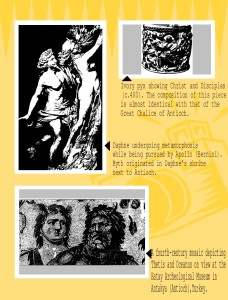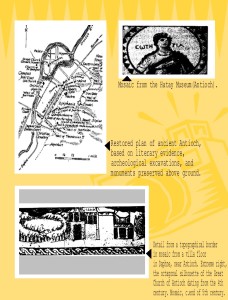Ignatius University traces its inspiration to ancient city of Antioch. The city was founded in 300 B.C. by Seleucus Nicator, a general of Alexander the Great. Seleucus named the city, situated on the Orontes river and twenty miles from the Mediterranean seacoast, after his father Antiochus.
Antioch, known as queen of the East, became the capital of the Seleucid kings of Syria. The city drew great wealth from the caravan trade to India and grew into a center of Greek learning and culture. An important Jewish colony thrived there. Just beyond the seventy foot walls lay the grove of Daphne with magnificent temples that attracted pilgrims from many parts of the world. Here arose the myth of the metamorphosis of Daphne escaping the pursuit of Apollo which was later immortalized in marble by Bernini.
The walled city was at the intersection of the freeways of the ancient world. A center of commerce, its architecture was rivaled only by Rome and Alexandria. The Romans subsequently added to the architectural splendors through temples, palaces, theatres and aqueducts.
In the first century, Barnabas and Paul converted a great multitude to Christianity. “It was at Antioch that the disciples were first called Christians,” Acts of the Apostles, 11:26. They used the synagogue as their platform to a liberal Jewish and Gentile community. Antioch was the home base of Paul’s journeys while Peter was the founder of the Church of Antioch and its first bishop. This is the foundation of the Syrian Orthodox Church and the seat of the Patriarchate for centuries.
The city, with a population of over a half million, had four quarters: Jewish, Syrian, Greek and African. Yet the church at the city center was international, multilingual and multiracial.
Antioch was a city of much theological dispute, controversy and creativity. Ignatius of Antioch, after whom the University is named, was bishop of the city. He is one of the Apostolic Fathers of the Church and disciple of John the Evangelist. On his way to execution in Rome (110), Ignatius wrote seven letters. They are an important source of information about the beliefs and organization of the early Christian church. Ignatius, Jerome, John Chrysostom and Nestorius were among the great luminaries. The later part of the fourth century was a golden age for Christianity. Orthodoxy celebrated by the construction of a cruciform church of St. Babylas and the octagonal Great Church of Antioch.
Like many Christians, St.John Chrysostom, later to become Patriarch of Constantinople, studied Greek literature and Rhetoric under Libanius, the celebrated “pagan” teacher who was at this time the leading citizen of the city. The simultaneous careers of teacher and pupil exemplify the interaction between “paganism” and Christianity at Antioch. In the fourth century, Christians were also being attracted to the Jewish cult at Antioch. They were drawn by the ceremonial, fasts, monotheistic teaching and the healing power of the Jewish martyrs.
In the sixth century, there were two major factions, the Green and the Blue which represented both political and theological differences.( Ignatius University takes green and blue as its colors as a sign of dialogue and reconciliation.) Because of theological controversy, Antioch had alienated itself from the Christian Emperor.
At one point the Antiochian Christians welcomed their new Arab and Persian rulers believing they would be more fairly treated than by Christian Constantinople.
The School of Philosophy in place for the study of Greek thought and rhetoric influenced the Antiochene theologians. The School of Theology was flowering under Lucian. Theologians trained in this School followed Aristotle’s historical and philosophical methods. Lucian’s scientific study of the text of the Bible was the foundation of the Antiochene Biblical scholarship. These scholars engaged in meticulous textual criticism with literal exegesis as against the allegorical methods of Alexandria.
Antioch has sustained fire (525), earthquakes (526, 528), invasion by Persians (540, 611), Arabs (638), Crusaders (1098), Muslims (1268), and Turks (1516). It remained part of the Ottoman Empire till shortly after World War I and went to Syria. Finally, in 1939 it was ceded to Turkey.
Antioch is known today as Antakya and remains a trading center without its former glory. One of our links to its splendid past is through the Hatay Museum which struggles to undertake the great amount of excavation needed to bring forth its vast riches.
It is difficult to say who founded our University and when. Shall we say it was the Jews, the Greeks, the Romans, the Christians, the Moslems? It is probably safe to say that all were founders and the time was whenever it was peaceful enough to educate without natural or man-made disasters interferring.
Accordingly, the Logo of Ignatius University contains the ancient Columns representing the Greeks and Romans, the Menorah for the Jews, the Octagon (shape or an early church) with Cross for Christianity, and the Crescent and Star for Islam. These are all within the embrace of the larger Cross.
The priests of the Syrian Orthodox Church have carefully chosen to pick up the fragments and lovingly to gather them together in creating a new place- “ever ancient, ever new”- not built solely by human hands.
The Ignatius University was chartered by the Secretary of State of the State of Indiana, in 1998, Indianapolis.


